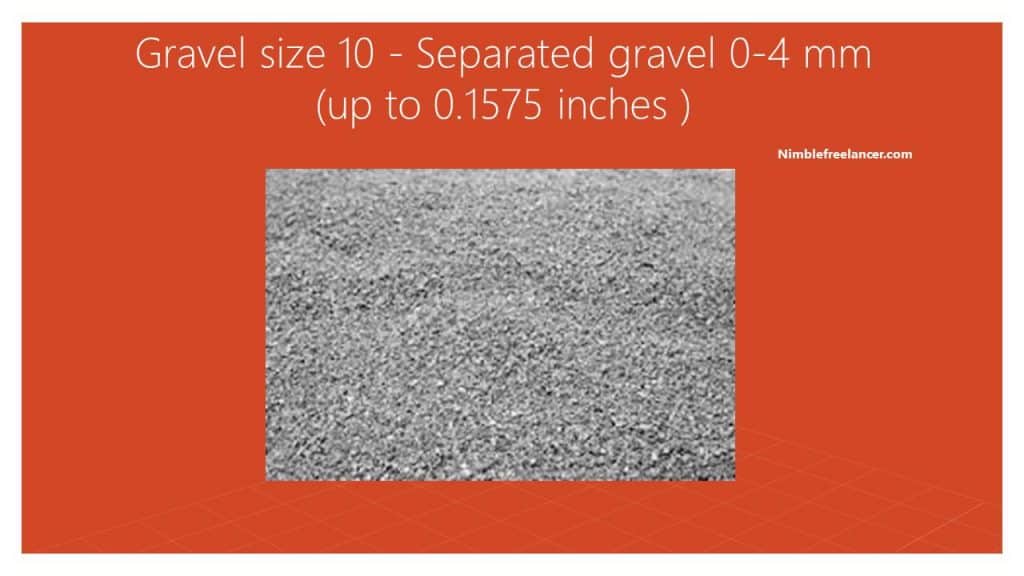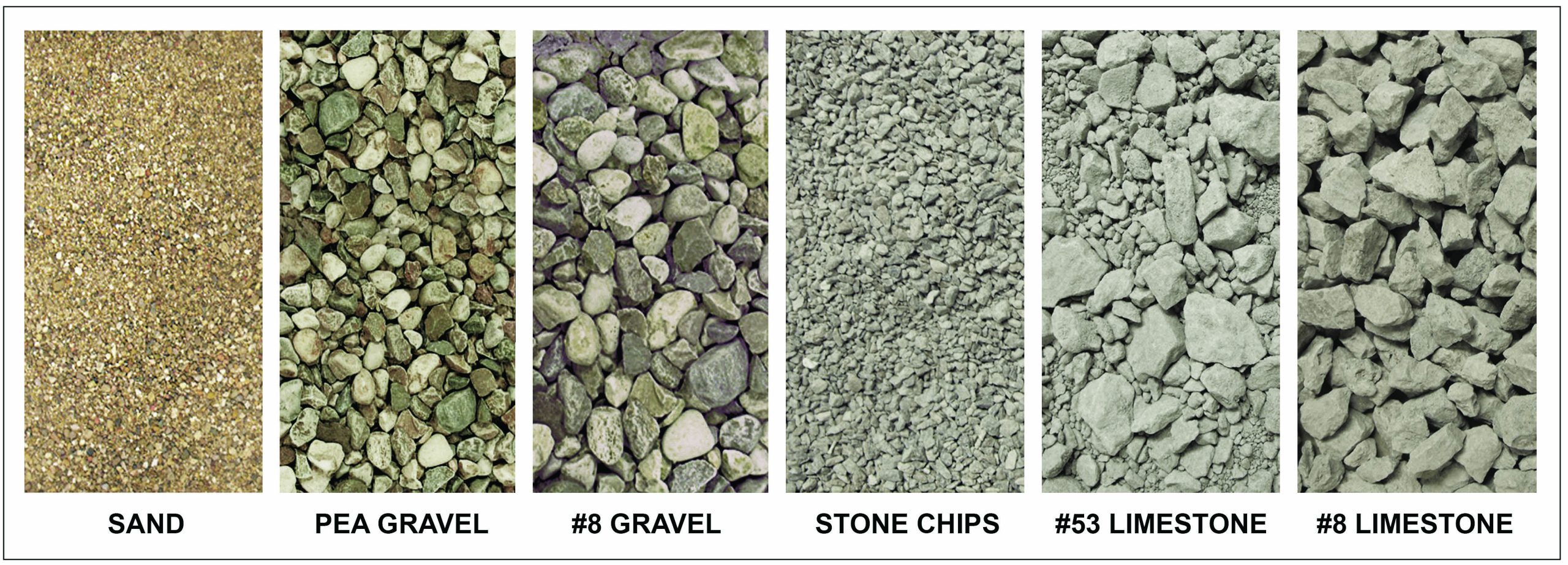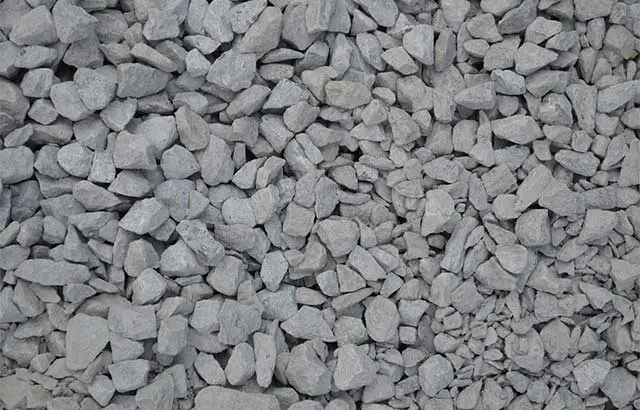Gravel is a versatile material commonly used for landscaping, construction, and road building. It comes in different sizes, each with specific applications. Understanding the different gravel sizes and their applications can help you choose the right type of gravel for your project.
Gravel sizes vary from one another. The soil is a mixture formed by the grinding of different gravels. They can be tiny, slightly bigger, pea-sized, or coin-shaped. Outlets and retailers in gravel-selling businesses classify gravel based on its use. The most miniature gravel size is #10, the largest is #1, and the medium-sized gravel is #1 size. People who enter the outlets to buy gravel should carefully analyze the demands of their projects. Unthinkingly, entering without prior analysis is a bad idea.
10 Gravel Size :

Ten gravel size is small gravel, usually from 0 to 4 mm (up to 0.1575 inches). Its primary purpose is to implement concrete accessories, cement screeds (parquet base), and external plastering.
Gravel Size list (inches)
Here are some common gravel sizes:
- Pea Gravel: 1/4 inch to 1/2 inch
- Crushed Stone #1: 1/4 inch to 1 inch
- Crushed Stone #2: 1 inch to 2 1/2 inches
- Crushed Stone #3: 2 1/2 inches to 4 inches
- Crushed Stone #4: 4 inches to 10 inches
- Rip-Rap: 6 inches to 9 inches
- River Rock: 1 inch to 6 inches
- Beach Pebbles: 1/2 inch to 2 1/2 inches
- Gravel Pathway Mix: 1/4 inch to 1/2 inch
- Decomposed Granite: Varies in size, from fine dust to 1/4-inch particles
Please see all gravel sizes with pictures in this video:
The sizing system used for classifying the gravel size is very distinct from one place to another. Sellers and manufacturers from all over the world use the standard guidelines. The distributors follow a set pattern and showcase the gravels in a similar format; for someone who requires strict sizing, it’s essential to discuss directly with the supplier.
The smallest gravel size is #10, generally used in pavements and basement floors. The gravel looks like sand and is referred to as screening gravel.
The smallest gravels are made from the weathering of big stones or extensive gravels (limestones or slag).
During road construction, size #67 gravel is used to fill the roadways, and size #5 gravel is used to fix the crevices in the more prominent segments.

Medium Gravel Size
Gravel 4-8 mm (from 0.15 til 0.3 inches in the US) – Purpose: mixed concrete with other fractions to produce concrete accessories. The medium-sized gravel size ranges from 3/4th of an inch to 1 inch. It’s preferable for filling in the sidewalks, pavements, and driveways. Size #57 is essential and is not used in areas prone to floods and mud.
Another standard size is #3 for residential draining projects. Size #8 goes with concrete and asphalt mixtures. A #57 and stone dust blend fills the potholes and leaky walls.
Gravel size#1 is meant for decoration purposes. It’s widely popular in gardens and flashy artifacts. Cutting into the big 2.4 to 4 inches of gravel isn’t easier. A variety of this gravel is available on river shores or from limestones.

Gravel by Size
- Pea Gravel Pea gravel is a popular choice for landscaping projects and is often used as a decorative material in gardens, pathways, and around trees. It ranges in size from 1/4 inch to 1/2 inch and is smooth and round. Pea gravel is easy to walk on and ideal for areas with required drainage.
- Crushed Stone #1 Crushed stone #1 is a versatile material commonly used in construction projects, road building, and landscaping. It ranges from 1/4 inch to 1 inch and is made by crushing larger stones. Crushed stone #1 has a variety of uses, including as a base material for pavers, as a drainage material, and for filling in holes and low spots in the yard.
- Crushed Stone #2 Crushed stone #2 is a larger size of crushed stone that ranges from 1 inch to 2 1/2 inches. It is commonly used as a base material for driveways, roads, and parking areas. Crushed stone #2 is also used in landscaping to create decorative features such as retaining walls and garden beds.
- Crushed Stone #3 Crushed stone #3 is a larger size of crushed stone, ranging from 2 1/2 inches to 4 inches. It is commonly used as a base material for driveways and roads, as well as drainage and erosion control. Crushed stone #3 is also used in landscaping to create natural-looking features such as rock gardens and waterfalls.
- Crushed Stone #4 Crushed stone #4 is the largest crushed stone and ranges from 4 inches to 10 inches. It is commonly used as a base material for driveways, roads, and parking areas. Crushed stone #4 is also used in landscaping to create significant, dramatic features such as boulders and retaining walls.
- Rip-Rap Rip-rap is a large gravel that ranges in size from 6 inches to 9 inches. It is commonly used for erosion control along shorelines, riverbanks, and steep slopes. Rip-rap is also used to prevent the formation of potholes and to protect roadways from washouts.
- River Rock is a popular choice for landscaping projects and is often used to create natural-looking features such as waterfalls and streams. It ranges in size from 1 inch to 6 inches and is smooth and rounded in shape. River rock is also commonly used for drainage and erosion control.
- Beach Pebbles Beach pebbles are a decorative type of gravel that ranges in size from 1/2 inch to 2 1/2 inches. They are smooth and round and come in a variety of colors. Beach pebbles are commonly used for landscaping projects such as garden beds, pathways, and around pools.
- Gravel Pathway Mix A Gravel pathway mix is a smaller gravel size that ranges from 1/4 inch to 1/2 inch. It is commonly used for landscaping projects such as garden pathways and as a base material for pavers.
- Decomposed Granite Decomposed granite is a gravel type made by crushing granite rock. It varies in size, from fine dust to 1/4-inch particles. Decomposed granite is commonly used for landscaping projects such as garden pathways, as a base material for patios and driveways, and as a substitute.
How to choose the best?
Gravel size depends on the project. When entering the store, you can never choose the gravel size solely based on the labels. The best practice is to read the product description carefully.
You can consult a Sales professional or contractor. They are experts in regional variations of gravel sizes.
- 6 Proven Ways SaaS Founders Actually Get Customers (With Real Examples) - December 17, 2025
- Facebook Ads to Get Followers! - December 27, 2024
- ClickUp vs. Slack - December 20, 2024






